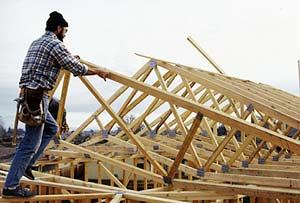Lacing. Truss companies provide plans that show where various permanent braces are meant to go. On production job sites, truss crews are usually well versed in bracing a standard plan, but these documents are necessary if the house is a new plan or a one-of-a-kind job. Building inspectors always check to make sure the lacing is in order after a roof is up (Figure 6).
As you stand the trusses, pull the lacing up and roughly spread it where it will be used. When nailing lacing, avoid nailing to the two end trusses until after they and the barge rafters have been adjusted. It is usually necessary to rack the barge and gable into a straight line, and a braced web and bottom chord makes the assembly too stiff to work with.
While one carpenter is struggling with the lacing, another can be busy cutting the eaves overhang to the proper length (Figure 7). Use a chalk line to mark the lengths and a bevel square to mark the tails at the necessary pitch. If the roof is long, I mark pencil lines along the string (instead of snapping the line) to ensure a straight eaves line.
Figure 7. Truss tails are marked with a string (top) and cut plumb. |
|
The final operation is straightening the barges and end trusses. One person can eye up the gable end from the ground and direct the other to spots where it has to go in or out. Nail a 2-by kicker to the side of the top chord at these points and angle it down to the bottom chords. Then nail a 2-by flat on the top of the bottom chords and extend it from the end truss back several trusses. Rest the gable kicker on this bottom nailer and move the kicker until the adjustment looks straight from the ground, then nail it off. Several kickers may be necessary to tame the gable and barge.
With good prep techniques, standing a modest-sized truss roof is a single day’s work. Due to the vast regional differences and building requirements, many aspects of trusses are not covered here. But one thing always remains the same: A carpenter is more efficient on the ground than climbing up, on, and around trusses. Learn to accomplish as much as possible on the ground before setting off eagerly to make a show out of raising a bunch of trusses, only to find yourself bogged down finishing off the details.
Don Dunkley is a construction supervisor and frequent JLC contributor who hails from Cool, Calif.
